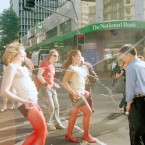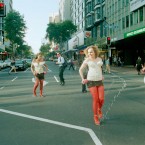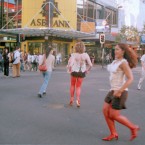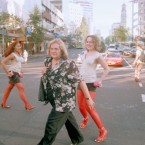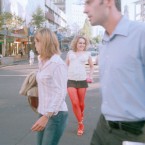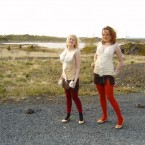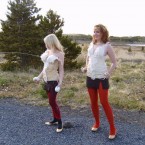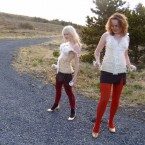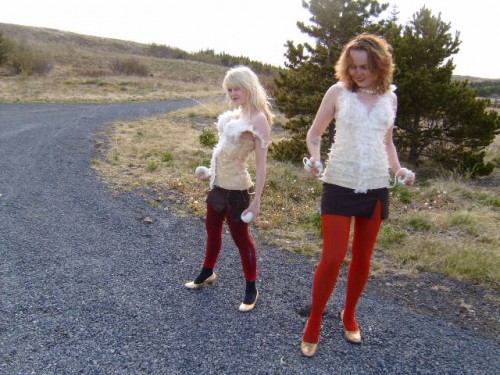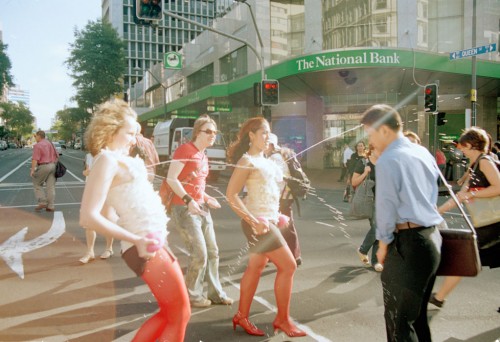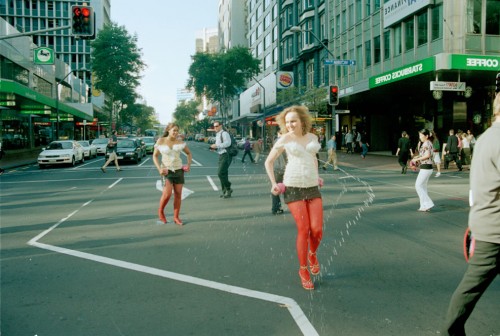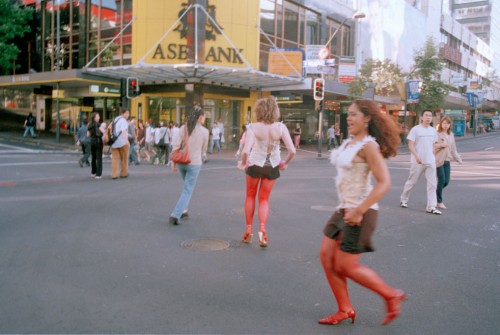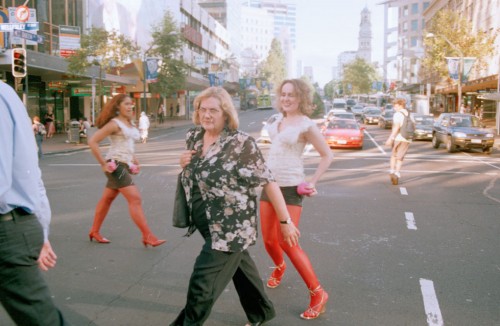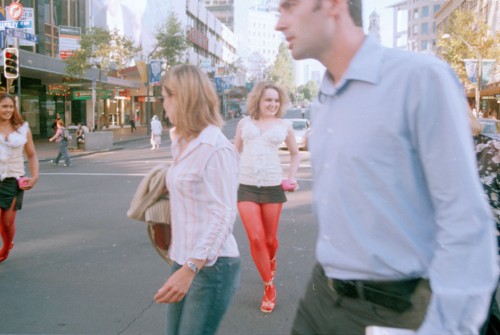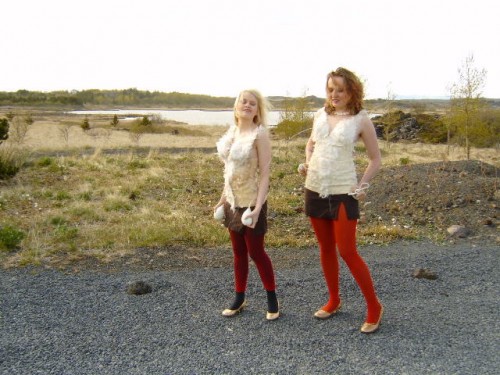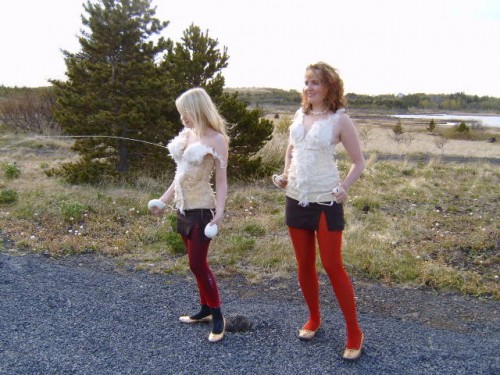I could be your Mother!
Performance by Pink Punk (Sandra Jogeva, Kristin Kalamees, Margus Tamm)
2004
Berlin
2005
Auckland, New Zealand
Near Reykjavik, Iceland
In the De-militarized Zone
Sandra Jogeva and Margus Tamm of PinkPunk/Avangard have been in New Zealand for the Auckland International Arts Festival AK05. Included in the festival was a survey of their work at the Gus Fisher Gallery curated by Robin Stoney and Marcus Williams and two street performances.
One of these, ‘I Could be your Mother’ was performed in Auckland in collaboration with New Zealand artist’s Bek Coogan and Norah Aarti. The women dressed up in provocative outfits which are a hybrid of hooker, power dressed female executive and exotic, urban bird. Chasing people in the street and blasting them from fake lactating breasts accentuates the allusions to maternity in the title of the work. The milky assault on the unsuspecting public is further problematised by the free card handed out by ‘pimp’, Margus Tamm, stating…‘I Could be your Mother’, a gesture more associated with business than maternity.
This satirical gesture takes a jab at the undervaluing of motherhood in contemporary capitalist society particularly in the deliberate blending of a ‘Cosmopolitan’ magazine perception of female sexuality and ‘Sex in the City’ thirty something careerism; both at odds with the demands of motherhood, exemplifying this very twenty first century evolutionary dilemma. As they hunt down their urban prey the predatory behavior of the women performing in ‘Mother’ is harmonized with their outfits. The unabashed use in the performance of various stereo-typical contemporary signifiers of female sexuality is clearly disconcerting for the public, particularly although not only the male ‘victims’. It is certainly fun to speculate whether the very vocal protests made about potentially damaging milk stains on expensive suits is not really the thinly disguised fear of sublimated oedipal emotion. For the wearer of the suit, both a powerful signifier and a signifier of power, becoming victim to an attack by an assailant who is dressed as your corporate adversary, who uses the very essence of maternal succor as a weapon and is sexually dynamic all at the same time is understandably disconcerting. Of course the PinkPunk art band would never wish to upset anybody, humble commentators as they are. Yet it is exactly this uncomfortable space between sexuality and maternity which makes the work so critically engaging. The viewer, and even more so the reluctant urban protagonist, are forced to confront the libidinal reality of the aesthetics of corporate power.
The relationship between desire and power is explored again in ‘Fair Deal’, performed at AK05 and also outside Parliament, in New Zealand’s capital city of Wellington. As one moves closer to the asinine blast of color against gray stone walls one sees Bek and Sandra dressed up in princess outfits, one red and one white. They hold signs saying ‘We Are Pretty Give Us Money’. A simple gesture; ‘Fair Deal’ seems to make the comment that prettiness is the most important qualification for women in a culture inundated with imagery portraying every conceivable variation of ideal feminine beauty. Yet belying the impression of simplicity, the begging action suggests that prettiness isn’t really a worthy qualification; more a condition for evoking sympathy, charity and the male desire to protect.
There is pathos in the image of these two glammed up fairy tale characters standing on some windy parliament steps; perhaps protagonists in some weird Disney version of a Harry.S.Truman documentary (he being the US President who conjured up the ‘Fair Deal’ post war economic rescue package), the location of the shoot signifying the various legislative devices aimed at protecting oppressed ‘minorities’, or ‘majority’ in the case of women.
Leaving the performance; having dropped a coin into the hat, one can’t help feeling slightly duped however, as if the charity was a scam, as if its not even a charity. Maybe the piece doesn’t really have any of this feminist/monetarist agenda after all and just says; looking good is cool, the high value of physical appearance is OK and anything of high value is worth giving money for isn’t it?. As Sandra said at a talk at the Gus Fisher Gallery…”People do it every day”.
On the other hand, the feeling of being duped could stem from having somehow bought into a gender based power struggle, one that you (if you are male, as I am) are loosing. These ‘nearly thirty’ princess’ are not asking for money, they’re demanding it. No point in waiting around for the knight in shining armor, just give us the cash mister, we earned it.
The same kind of slippery authorial position appeared to be the case in the video installation ‘The Bomb’ at Wellingtons ‘Enjoy’ gallery. As one enters one can’t help being soothed by the nostalgic, part funereal, part fantastic piano chords of the soundtrack to the projection. Evocative of background music to some documentary film on the holocaust the endlessly repeated combination of five or six piano notes are in fact a highly abstracted variation on the opening chords to Michael Jackson’s ‘Earth Song’. The projection itself consists of still images taken in a variety of locations which form the backdrop to a knee high model of a ‘nuclear mushroom’. As if to undermine the appalling significance of this image, the thing is kitsch, a radio active Pavlova (iconic New Zealand vernacular, a type of meringue cake); Disney comes to mind again…this is fallout from ‘Fantasia’. Like a lovable albino opossum (a marsupial from Australia which released into the New Zealand context is devastating the native flaura and fauna), at once cute and yet highly destructive, ‘The Bomb’ bursts out between the legs of a glossy magazine style bathing girl, looking for all the world like a big macho bath bubble blending into the frothy mounds of foam and steam. In another sequence, Margus Tamm is busted at customs, his own surprise appearing as great as the officials when ‘The Bomb’ pops out of his suitcase; an old woman opens the door to her apartment and finds ‘The Bomb’; there it is again on the mantle piece of a chic designer apartment, in a beautiful summery garden; silhouetted against a fair ground sunset. Sexy, trans global, trendy and wholesome, ‘The Bomb’ makes the perfect gift, garden sculpture or living room conversation piece.
Nuclear war has been the possible, ultimate, apocalyptic danger for so long; the public can’t take it seriously anymore. The nuclear mushroom can now be a powerful cultural symbol, an icon. So why not make small ‘souvenir’ mushrooms that would look good in your lounge or backyard?
But what’s that image directly between bathtub shenanigans and garden ornament? Is that our cuddly bomb in a graveyard? And after the “House and Garden’ interior design magazine bomb, in a classically utopian Soviet monument.
“Soviet propaganda used to demonize Ronald Reagan, so for us as elementary school
children he seemed to be a raging lunatic who wanted to destroy the world. He
was the boogie man of our childhood. Our scared teachers used to tell us… the
nuclear war will begin before you grow up”.
AvantGard2004
This work is an ironic comment on the decades-long hysteria about nuclear threat and growing up in the shadow of imminent nuclear disaster. For a New Zealand audience, this has the paradoxical quality of coming ‘from the other side’; from beyond ‘The Iron Curtain’. Of course it was always the Russian maniacs who threatened the planet, as we gazed at pictures of Ronnie out riding a Western saddle at Camp David or ultra sound pictures of his colonic cancer.
‘The Bomb’ is an especially poignant art work for New Zealand; here the relationship with nuclear weapons was quite different to Europe or America, geographic isolation from the main stages of the Cold War allowed an idealism which was unusual for the times. The countries David and Goliath stand over US nuclear armed warships and previous New Zealand Prime Minister David Lange’s refusal to allow them access came after protests which saw the Auckland Harbour completely blockaded by private vessels. People who didn’t have boats built rafts and before long the Labour Government of the day made the decision to form the worlds first Nuclear Free country. The Americans would neither confirm nor deny the presence of nuclear weapons on their ships and submarines and were subsequently banned. The same Government implemented an unrelenting protest against French nuclear testing in the Pacific. The use of Auckland Harbour as the base for Greenpeace during the most radical phase of its nuclear disarmament campaign brought things to a head and resulted in New Zealand’s one and only incident of international terrorism. The ‘Rainbow Warrior’ bombing, perpetrated by the French military resulted in the sinking of Greenpeace’s prize protest ship and the death of one crew member. The media attention gained by the bungled French operation (both the bombers were apprehended) failed to stop the desecration of the pristine coral atoll of Muroroa. So you see, ‘The Bomb’ as garden ornament in a typical subtropical Auckland Garden poses very specific challenges.
Preferring also not to ‘confirm or deny’ the work of PinkPunk/Avangard, although highly political and socially engaged, avoids the one dimensionality of much polemical art. While the aesthetic clues and conceptual concerns of its post Soviet, Eastern bloc origins are discernible, the work manages to transcend the typical concerns of regionally focused identity art and presents ideas which can be thought provoking to all viewers and participants. As you pop a coin into the begging hat of a glammed up princess or gaze, mesmerized by the cinematic music accompanying the ‘cute apocalypse’, or get a face full of mothers milk while strolling down to the stock exchange to dabble in the futures market, you realize there is a common theme here. That fairy tale princess’, return to the earth-breast feeding naturalists and peace on earth through military balance all have shades of utopianism and that PinkPunk/Avangard are as skeptical as all hell about it.
Marcus Williams is an artist and teacher living in Auckland.
Photos of the performance in New Zealand Marcus Williams
